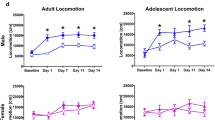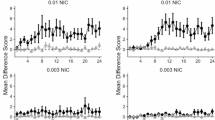Abstract
Nicotine dependence is a serious public health concern. Optimal treatment of nicotine dependence will require greater understanding of the mechanisms that contribute to the maintenance of smoking behaviors. A growing literature indicates sex and menstrual phase differences in responses to nicotine. The aim of this study was to assess sex and menstrual phase influences on a broad range of measures of nicotine response including subjective drug effects, cognition, physiological responses, and symptoms of withdrawal, craving, and affect. Using a well-established intravenous nicotine paradigm and biochemical confirmation of overnight abstinence and menstrual cycle phase, analyses were performed to compare sex (age 18–50 years; 115 male and 45 female) and menstrual cycle phase (29 follicular and 16 luteal) effects. Females had diminished subjective drug effects of, but greater physiological responses to, nicotine administration. Luteal-phase females showed diminished subjective drug effects and better cognition relative to follicular-phase women. These findings offer candidate mechanisms through which the luteal phase, wherein progesterone is dominant relative to estradiol, may be protective against vulnerability to smoking.
Similar content being viewed by others
Log in or create a free account to read this content
Gain free access to this article, as well as selected content from this journal and more on nature.com
or
References
al'Absi M, Amunrud T, Wittmers LE (2002). Psychophysiological effects of nicotine abstinence and behavioral challenges in habitual smokers. Pharmacol Biochem Behav 72: 707–716.
Allen AM, Allen SS, Widenmier J, Al'absi M (2009). Patterns of cortisol and craving by menstrual phase in women attempting to quit smoking. Addict Behav 34: 632–635.
Allen SS, Bade T, Center B, Finstad D, Hatsukami D (2008a). Menstrual phase effects on smoking relapse. Addiction 103: 809–821.
Allen SS, Bade T, Hatsukami D, Center B (2008b). Craving, withdrawal, and smoking urges on days immediately prior to smoking relapse. Nicotine Tob Res 10: 35–45.
Anker JJ, Carroll ME (2011). Females are more vulnerable to drug abuse than males: evidence from preclinical studies and the role of ovarian hormones. Curr Top Behav Neurosci 8: 73–96.
Benowitz N, Ahijevych K, Jarvis MJ, LeHouezec J, Lichtenstein E, Henningfield JE et al (2002). Biochemical verification of tobacco use and cessation. Report from the SRNT Subcommittee on Biochemical Verification. Nicotine Tob Res 4: 149–159.
Benowitz NL, Hatsukami D (1998). Gender differences in the pharmacology of nicotine addiction. Addict Biol 3: 383–404.
Benowitz NL, Lessov-Schlaggar CN, Swan GE, Jacob P 3rd (2006). Female sex and oral contraceptive use accelerate nicotine metabolism. Clin Pharmacol Ther 79: 480–488.
Carpenter MJ, Saladin ME, Leinbach AS, Larowe SD, Upadhyaya HP (2008). Menstrual phase effects on smoking cessation: a pilot feasibility study. J Womens Health (Larchmt) 17: 293–301.
Carpenter MJ, Upadhyaya HP, LaRowe SD, Saladin ME, Brady KT (2006). Menstrual cycle phase effects on nicotine withdrawal and cigarette craving: a review. Nicotine Tob Res 8: 627–638.
Cepeda-Benito A, Reynoso JT, Erath S (2004). Meta-analysis of the efficacy of nicotine replacement therapy for smoking cessation: differences between men and women. J Consult Clin Psychol 72: 712–722.
Cox LS, Tiffany ST, Christen AG (2001). Evaluation of the brief questionnaire of smoking urges (QSU-brief) in laboratory and clinical settings. Nicotine Tob Res 3: 7–16.
Danaei G, Ding EL, Mozaffarian D, Taylor B, Rehm J, Murray CJ et al (2009). The preventable causes of death in the United States: comparative risk assessment of dietary, lifestyle, and metabolic risk factors. PLoS Med 6: e1000058.
DeBon M, Klesges RC, Klesges LM (1995). Symptomatology across the menstrual cycle in smoking and nonsmoking women. Addict Behav 20: 335–343.
Evans SE, Blank M, Sams C, Weaver MF, Eissenberg T (2006). Transdermal nicotine-induced tobacco abstinence symptom suppression: nicotine dose and smokers’ gender. Exp Clin Psychopharmacol 14: 121–135.
First MB, Spitzer RL, Gibbon M, Williams JB (1996) Structured Clinical Interview for DSM-IV Axis I Disorders—Patient Edition. Biometrics Research Department, New York State Psychiatric Institution: New York.
Franklin TR, Allen SS (2009). Influence of menstrual cycle phase on smoking cessation treatment outcome: a hypothesis regarding the discordant findings in the literature. Addiction 104: 1941–1942.
Franklin TR, Ehrman R, Lynch KG, Harper D, Sciortino N, O'Brien CP et al (2008). Menstrual cycle phase at quit date predicts smoking status in an NRT treatment trial: a retrospective analysis. J Womens Health (Larchmt) 17: 287–292.
Hughes JR, Hatsukami D (1986). Signs and symptoms of tobacco withdrawal. Arch Gen Psychiatry 43: 289–294.
Hukkanen J, Gourlay SG, Kenkare S, Benowitz NL (2005). Influence of menstrual cycle on cytochrome P450 2A6 activity and cardiovascular effects of nicotine. Clin Pharmacol Ther 77: 159–169.
Justice AJ, de Wit H (1999). Acute effects of d-amphetamine during the follicular and luteal phases of the menstrual cycle in women. Psychopharmacology (Berl) 145: 67–75.
Leventhal AM, Waters AJ, Boyd S, Moolchan ET, Lerman C, Pickworth WB (2007). Gender differences in acute tobacco withdrawal: effects on subjective, cognitive, and physiological measures. Exp Clin Psychopharmacol 15: 21–36.
Lynch WJ, Roth ME, Carroll ME (2002). Biological basis of sex differences in drug abuse: preclinical and clinical studies. Psychopharmacology (Berl) 164: 121–137.
Marks JL, Pomerleau CS, Pomerleau OF (1999). Effects of menstrual phase on reactivity to nicotine. Addict Behav 24: 127–134.
Masson CL, Gilbert DG (1999). Cardiovascular and mood responses to quantified doses of cigarette smoke in oral contraceptive users and nonusers. J Behav Med 22: 589–604.
Mazure CM, Toll B, McKee SA, Wu R, O'Malley SS (2011). Menstrual cycle phase at quit date and smoking abstinence at 6 weeks in an open label trial of bupropion. Drug Alcohol Depend 114: 68–72.
Mendelson JH, Sholar MB, Goletiani N, Siegel AJ, Mello NK (2005). Effects of low- and high-nicotine cigarette smoking on mood states and the HPA axis in men. Neuropsychopharmacology 30: 1751–1763.
Merritt PS, Cobb AR, Cook GI (2012). Sex differences in the cognitive effects of tobacco abstinence: a pilot study. Exp Clin Psychopharmacol 20: 258–263.
Munafo M, Bradburn M, Bowes L, David S (2004). Are there sex differences in transdermal nicotine replacement therapy patch efficacy? A meta-analysis. Nicotine Tob Res 6: 769–776.
Myers CS, Taylor RC, Moolchan ET, Heishman SJ (2008). Dose-related enhancement of mood and cognition in smokers administered nicotine nasal spray. Neuropsychopharmacology 33: 588–598.
Netter P, Muller MJ, Neumann A, Kamradik B (1994). The influence of nicotine on performance, mood, and physiological parameters as related to smoking habit, gender, and suggestibility. Clin Investig 72: 512–518.
O'Hara P, Portser SA, Anderson BP (1989). The influence of menstrual cycle changes on the tobacco withdrawal syndrome in women. Addict Behav 14: 595–600.
Perkins KA (2009a). Discriminative stimulus effects of nicotine in humans. Handb Exp Pharmacol 192: 369–400.
Perkins KA (2009b). Sex differences in nicotine reinforcement and reward: influence on the persistence of tobacco smoking. Nebr Symp Motiv 55: 143–169.
Pickworth WB, Fant RV (1998). Endocrine effects of nicotine administration, tobacco and other drug withdrawal in humans. Psychoneuroendocrinology 23: 131–141.
Pomerleau CS, Carton SM, Lutzke ML, Flessland KA, Pomerleau OF (1994). Reliability of the Fagerstrom Tolerance Questionnaire and the Fagerstrom Test for Nicotine Dependence. Addict Behav 19: 33–39.
Pomerleau CS, Garcia AW, Pomerleau OF, Cameron OG (1992). The effects of menstrual phase and nicotine abstinence on nicotine intake and on biochemical and subjective measures in women smokers: a preliminary report. Psychoneuroendocrinology 17: 627–638.
Reeves D, Winter K, Kane R, Elsmore T, Bleiberg J (2002). ANAM 2001’s User’s Manual. National Cognitive Recovery Foundation.
Schiller CE, Saladin ME, Gray KM, Hartwell KJ, Carpenter MJ (2012). Association between ovarian hormones and smoking behavior in women. Exp Clin Psychopharmacol 20: 251–257.
Sofuoglu M, Babb DA, Hatsukami DK (2001). Progesterone treatment during the early follicular phase of the menstrual cycle: effects on smoking behavior in women. Pharmacol Biochem Behav 69: 299–304.
Sofuoglu M, Dudish-Poulsen S, Nelson D, Pentel PR, Hatsukami DK (1999). Sex and menstrual cycle differences in the subjective effects from smoked cocaine in humans. Exp Clin Psychopharmacol 7: 274–283.
Sofuoglu M, Herman AI, Nadim H, Jatlow P (2012). Rapid nicotine clearance is associated with greater reward and heart rate increases from intravenous nicotine. Neuropsychopharmacology 37: 1509–1516.
Sofuoglu M, Mitchell E, Kosten TR (2004). Effects of progesterone treatment on cocaine responses in male and female cocaine users. Pharmacol Biochem Behav 78: 699–705.
Sofuoglu M, Mitchell E, Mooney M (2009). Progesterone effects on subjective and physiological responses to intravenous nicotine in male and female smokers. Hum Psychopharmacol 24: 559–564.
Sofuoglu M, Mooney M (2009). Subjective responses to intravenous nicotine: greater sensitivity in women than in men. Exp Clin Psychopharmacol 17: 63–69.
Sofuoglu M, Mouratidis M, Mooney M (2011). Progesterone improves cognitive performance and attenuates smoking urges in abstinent smokers. Psychoneuroendocrinology 36: 123–132.
Sofuoglu M, Yoo S, Hill KP, Mooney M (2008). Self-administration of intravenous nicotine in male and female cigarette smokers. Neuropsychopharmacology 33: 715–720.
USDHHS (2001). Women and Smoking: A Report of the Surgeon General.
Watson D, Clark LA, Tellegen A (1988). Development and validation of brief measures of positive and negative affect: the PANAS scales. J Pers Soc Psychol 54: 1063–1070.
Acknowledgements
We thank Stacy Minnix, Lance Barnes, Katherine Barrett, Christopher Cryan, and Ellen Mitchell for their valuable contributions to study, including help with subject recruitment and data collection. We also thank the participants for their time. This research was supported by the National Institute on Drug Abuse (NIDA) (R01 DA12690, R01 DA12849, R03 DA027474) and the Veterans Administration Mental Illness Research, Education and Clinical Center (MIRECC). EED was supported by K12 DA031050 from NIDA, National Institute on Alcohol Abuse and Alcoholism (NIAAA), Office of Research on Women’s Health (ORWH), and NIH Office of the Director (OD). AIH was supported by K12 DA00167 from NIDA.
Author information
Authors and Affiliations
Corresponding author
Additional information
Supplementary Information accompanies the paper on the Neuropsychopharmacology website
PowerPoint slides
Rights and permissions
About this article
Cite this article
DeVito, E., Herman, A., Waters, A. et al. Subjective, Physiological, and Cognitive Responses to Intravenous Nicotine: Effects of Sex and Menstrual Cycle Phase. Neuropsychopharmacol 39, 1431–1440 (2014). https://doi.org/10.1038/npp.2013.339
Received:
Revised:
Accepted:
Published:
Issue date:
DOI: https://doi.org/10.1038/npp.2013.339
Keywords
This article is cited by
-
Catechol-O-Methyltransferase Effects on Smoking: a Review and Proof of Concept of Sex-Sensitive Effects
Current Behavioral Neuroscience Reports (2022)
-
Development of pulsed intravenous nicotine infusions as a model for inhaled nicotine in humans
Psychopharmacology (2022)
-
Threshold dose for intravenous nicotine self-administration in young adult non-dependent smokers
Psychopharmacology (2021)
-
Differential effects of nicotine delivery rate on subjective drug effects, urges to smoke, heart rate and blood pressure in tobacco smokers
Psychopharmacology (2020)
-
Nocturnal finger skin temperature in menstrual cycle tracking: ambulatory pilot study using a wearable Oura ring
BMC Women's Health (2019)



